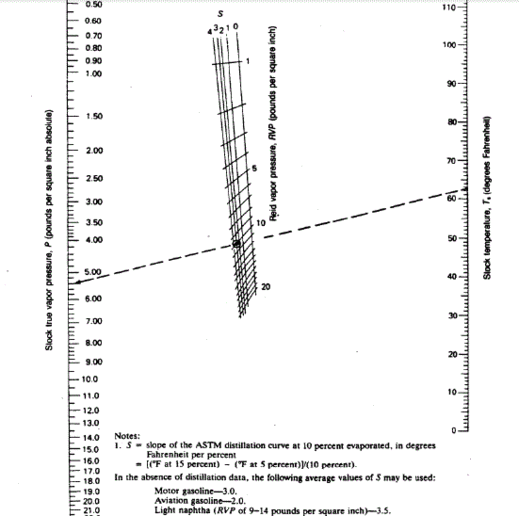MarkB_MI
Well-known Member
- Location
- Motown USA
Ken, I started a new thread because the old one is about the scroll off into the archives. You bring up some good points about Reid Vapor Pressure and whether or not it's in units of absolute or gauge pressure.
From your post:
"RVP is measured using a bomb containing 4 parts air and 1 part chilled gasoline. The bomb is sealed and immersed in a 100 degree F water bath. Once the bomb and contents have stabilized at 100 degrees F the RVP is read on the attached pressure gauge. Therefore, the pressure gauge reads only the pressure increase from the initial condition to the final condition and is in units of PSIG."
I didn't know the exact method used, but this helps explain the ambiguity. The RVP test is a simple, repeatable method to indirectly measure vapor pressure. To directly measure true vapor pressure, you would need to introduce gasoline into an evacuated chamber, something that is not particularly easy to do. So the RVP test is much simpler, yet yields results that are close enough, and more importantly are repeatable. Which explains why the words "absolute" and "gauge" aren't used in the units of RVP. Rather, it's simply "RVP of nn.n PSI". Sort of like the MIT students who measured the length of Harvard Bridge in "smoots"; the measurement is only useful if you are comparing it with the lengths of other bridges which were also measured in smoots.
So, getting back to the measurement, if you were to take that same bomb without adding anything but air to it, and repeated the test, you would get a reading of close to zero psig, which is the pressure exerted by the air in the vessel. Presumably you started with 70 degree F air, so the pressure would be slightly positive. Remember that the total vapor pressure will be the sum of the partial pressures exerted by the different gasses in the vessel. In the RVP test, those gasses will be primarily nitrogen, oxygen and the vapors of the various distillates in gasoline. By using gauge pressure, you're more or less subtracting out the partial pressure contribution of nitrogen and oxygen, leaving just the partial pressure generated by the gasoline. Not exactly the same as absolute vapor pressure, but close enough.
One more comment: It isn't coincidental that the maximum RVP for automotive fuel is around 14 psi and is typically less. 14 psi is about as high as you can go and not risk having the gasoline boil in the tank. Likewise, avgas is limited to 7 psi RVP because that gives a comfortable safety margin at typical altitudes where reciprocating engines operate. Atmospheric pressure drops to 7 psi at around 20,000 feet, but because the temperature is colder at altitude, the 7 psi RVP still provides a margin of safety. Recip engines seldom operate over 30,000 feet, where the pressure is about 4 psi and the temperature is about -50F.
From your post:
"RVP is measured using a bomb containing 4 parts air and 1 part chilled gasoline. The bomb is sealed and immersed in a 100 degree F water bath. Once the bomb and contents have stabilized at 100 degrees F the RVP is read on the attached pressure gauge. Therefore, the pressure gauge reads only the pressure increase from the initial condition to the final condition and is in units of PSIG."
I didn't know the exact method used, but this helps explain the ambiguity. The RVP test is a simple, repeatable method to indirectly measure vapor pressure. To directly measure true vapor pressure, you would need to introduce gasoline into an evacuated chamber, something that is not particularly easy to do. So the RVP test is much simpler, yet yields results that are close enough, and more importantly are repeatable. Which explains why the words "absolute" and "gauge" aren't used in the units of RVP. Rather, it's simply "RVP of nn.n PSI". Sort of like the MIT students who measured the length of Harvard Bridge in "smoots"; the measurement is only useful if you are comparing it with the lengths of other bridges which were also measured in smoots.
So, getting back to the measurement, if you were to take that same bomb without adding anything but air to it, and repeated the test, you would get a reading of close to zero psig, which is the pressure exerted by the air in the vessel. Presumably you started with 70 degree F air, so the pressure would be slightly positive. Remember that the total vapor pressure will be the sum of the partial pressures exerted by the different gasses in the vessel. In the RVP test, those gasses will be primarily nitrogen, oxygen and the vapors of the various distillates in gasoline. By using gauge pressure, you're more or less subtracting out the partial pressure contribution of nitrogen and oxygen, leaving just the partial pressure generated by the gasoline. Not exactly the same as absolute vapor pressure, but close enough.
One more comment: It isn't coincidental that the maximum RVP for automotive fuel is around 14 psi and is typically less. 14 psi is about as high as you can go and not risk having the gasoline boil in the tank. Likewise, avgas is limited to 7 psi RVP because that gives a comfortable safety margin at typical altitudes where reciprocating engines operate. Atmospheric pressure drops to 7 psi at around 20,000 feet, but because the temperature is colder at altitude, the 7 psi RVP still provides a margin of safety. Recip engines seldom operate over 30,000 feet, where the pressure is about 4 psi and the temperature is about -50F.


